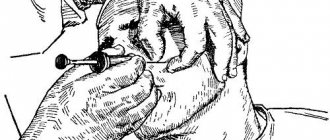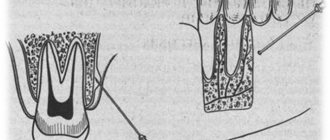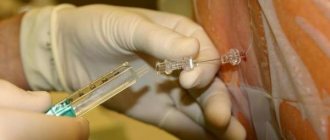Technique of infiltration anesthesia
The method of infiltration anesthesia was developed at the end of the 19th century, but the anesthetics used at that time were highly toxic.
The technique became more widespread after the introduction of novocaine into practice. This agent could be administered in larger volumes without significant risk of toxicity. The disadvantages of infiltration anesthesia at that time were: delayed development of anesthesia, the need for additional tissue infiltration during surgery, and the risk of toxic effects of the anesthetic. A.V. managed to eliminate these shortcomings. Vishnevsky, who proposed the technique of tight “creeping infiltration”. The method is still widely used in small operations. Features of the technique include the use of a weak solution of novocaine (0.25%) and infiltration of a large volume of anesthetic into fascial closed spaces. The anesthetic solution is injected into the tissue under increased pressure and spreads over a considerable distance within the fascial sheath, while the drug acts on the axons of neurons innervating the intervention area. High hydrostatic pressure promotes closer contact of novocaine with nerve endings. This leads to a rapid development of anesthesia and allows the surgeon to immediately begin the operation. In addition, thanks to the “creeping infiltration” method, hydraulic tissue preparation is ensured, facilitating such surgical procedures as the separation of adhesions, tumor isolation, and others.
Anesthesia technique
A solution of novocaine is injected intradermally with a thin needle, warmed to body temperature. As a result, a “lemon peel” is formed at the site of the upcoming cut. Then a thicker needle is used to infiltrate the subcutaneous tissue and create a subcutaneous novocaine infiltrate. After this, the skin and subcutaneous tissue are dissected to the aponeurosis. Following this, the subgaleal space is tightly filled with novocaine solution, ending with the opening of the aponeurosis. If the intervention requires it, subsequent anesthesia of the peritoneum, mesentery or pleura, and the root of the lung is performed. In all cases, when performing infiltration anesthesia, the surgeon adheres to the rule - infiltration with an anesthetic must precede an incision with a scalpel. Novocaine blockades proposed by A.V. are based on a similar principle. Vishnevsky. It also uses tight filling of anatomical “cases” with anesthetic, which does not require direct application of the drug to the nerve trunks.
Conduction anesthesia
With conduction anesthesia, the anesthetic is injected into the area of the nerve trunk that innervates the surgical area. For example, during operations on the fingers, the anesthetic is injected at the base of the finger, and during operations on the upper limb - into the brachial plexus area. For conduction anesthesia, higher concentrations of anesthetics are used (1-2% solutions of lidocaine and novocaine), but in smaller volumes than for infiltration anesthesia. After administration of the anesthetic, complete anesthesia requires time (5-10 minutes), during which the anesthetic penetrates the entire thickness of the nerve.
Types of infiltration anesthesia
Conventionally, two types of infiltration anesthesia can be distinguished: direct and indirect. With direct anesthesia, the drug is injected directly into the surgical area. This type of anesthesia is used during soft tissue operations.
With the indirect (diffuse) type of infiltration anesthesia, the anesthetic is administered at some distance from the area that needs to be anesthetized. By diffusion, the solution reaches the tissues in the intervention area. For example, introducing an anesthetic solution around the surgical field when opening an abscess or injection under the periosteum when numbing a tooth. The effect of the drug is determined not only by the pharmacokinetic properties, concentration and amount of solution, but also by the condition of the infiltrated tissues (local inflammation, scar-adhesive process reduce the analgesic effect).
Indications for infiltration anesthesia
Infiltration anesthesia is used in the following cases:
- in the treatment of dental diseases (caries, pulpitis, etc.);
- for dental implantation and prosthetics;
- when removing teeth;
- when cutting the gums;
- when opening purulent tumors;
- during surgical interventions in the oral cavity (for example, cutting the frenulum of the tongue).
Options for using infiltration anesthesia
The technique of local anesthesia has its own characteristics depending on the type of operation and area of intervention. Currently, the classic version of infiltration anesthesia according to A.V. Vishnevsky is rarely used, but its elements continue to be used during various operations, including abdominal interventions.
One type of infiltration anesthesia is case blockade . It may be required for injuries or operations on the extremities. It is performed using a 0.25% solution of novocaine, trimecaine or lidocaine by introducing flexors or extensors into the sheaths. To do this, the skin and muscles are anesthetized, and then using a thin needle they reach the bone and, retreating a few millimeters, inject a certain amount of anesthetic. The drug is usually administered from two points. For closed fractures of the tubular bones of the extremities, the anesthetic can be injected directly into the hematoma.
Several types of infiltration anesthesia are used in dentistry: intramucosal, submucosal, spongy anesthesia, intrapulpal, intraligamentary, infiltration anesthesia of soft tissues, anesthesia under the periosteum.
Local infiltration anesthesia according to Vishnevsky.
Local infiltration anesthesia according to Vishnevsky.
Indications: Used as a method of pain relief during surgical treatment of wounds; at the initial stages of conduction anesthesia and blockade of cellular spaces; during puncture of serous cavities and pathological space-occupying formations; when opening post-injection abscesses, boils and suppurating atheromas; when removing benign tumors of the skin and subcutaneous fat (papillomas, lipomas, fibromas), removing various types of granulomas. This method can also be used as a method of “hydraulic preparation” of tissue (for example, when isolating a hernial sac).
Contraindications: diffuse purulent inflammation, neuropsychiatric diseases and disorders.
Pathogenetic rationale: The method of infiltration anesthesia according to Vishnevsky is based on the teaching of N. I. Pirogov about the case structure of the human body. In his works, A. V. Vishnevsky writes “During the operation, strictly layer-by-layer and anatomical administration of weak solutions of novocaine in the form of a creeping infiltrate under the skin, fascial sheaths, aponeuroses, preperitoneal tissue, as well as duplication of the peritoneum, the goal is to block the nerve endings by direct contact with them of the anesthetic solution, which accelerates the onset of the analgesic effect.”
Technique: Layer-by-layer infiltration anesthesia involves alternating a scalpel and a syringe with an anesthetic solution during the operation. First, along the line of the intended incision, the skin is anesthetized by forming an intradermal novocaine nodule (creating a “lemon peel” - Fig. 1), then a tight novocaine infiltrate is created in the subcutaneous fat fiber. In this case, it is necessary to observe the principle “the end of the needle follows the stream of novocaine.”
Rice. 1. Lemon peel type skin anesthesia.
The intradermal position of the needle allows you to change its direction within 360˚ and inject the anesthetic in a fan-shaped manner. If you need to refill the syringe with novocaine, you should not remove the needle, just remove the syringe from the needle. When pain relief is performed correctly, the patient only feels the first injection. After anesthesia of the subcutaneous fat tissue, if necessary, anesthesia of the deeper-lying fascial sheaths is also performed by means of a tight creeping infiltrate and, as a rule, after dissection of the skin and subcutaneous tissue.
Tool kit and medications necessary to perform the practical skill: antiseptic for skin treatment; 0.25% novocaine solution; syringe; sterile gloves.
Anesthesia (blockade) of the site of a tubular bone fracture.
Indications: closed fractures of long bones.
The method refers to local infiltration anesthesia, while peripheral pain analyzers are blocked.
Technique: The skin over the site of a closed fracture is anesthetized in a “lemon peel” manner. The needle insertion site should be away from the projection of the great vessels and nerve trunks and only through intact skin. The hematoma is punctured with a needle, as evidenced by the flow of blood into the syringe during the reverse stroke of the piston, and 10-50 ml of a 1-2% anesthetic solution is injected. Do not insert a needle into a place where bone fragments are located directly under the skin. In case of multiple fractures, each segment is anesthetized separately, taking into account the total amount of anesthetic, reducing its concentration accordingly.
Tool kit and medications necessary to perform the practical skill: antiseptic for skin treatment; syringe; sterile gloves; ampoules with 1-2% anesthetic solution for infiltration anesthesia (novocaine, lidocaine, prilocaine, trimecaine, chloroprocaine).
Spinal anesthesia.
Indications: Spinal anesthesia is used for surgical interventions on the lower half of the body: the lower floor of the peritoneal cavity, perineum, lower extremities (for example, for hernia repair, hip replacement, appendectomy, uterine amputation, venectomy of the lower extremities, etc.).
Contraindications: There are absolute and relative contraindications to spinal anesthesia:
Absolute contraindications: increased intracranial and spinal pressure; diseases of the central nervous system; skin infection at the puncture site; severe hypovolemia; severe arterial hypotension (below 90 mm Hg); sepsis.
Relative contraindications: previous spinal surgeries; spinal column deformities; back pain, psycho-emotional lability of the patient; hypertensive crisis .
Pathogenetic rationale: In this case, it is necessary to recall some anatomical issues. The spinal cord is located in the spinal canal, formed by the posterior surface of the vertebral bodies and their arches and surrounded by membranes. Between the arachnoid membrane, directly adjacent to the spinal cord, and the dura mater, a space is formed filled with cerebrospinal fluid (CSF). The dura mater is impermeable to fluid and performs a protective function for the spinal cord. In the cranial direction, the dura mater of the spinal cord passes into the dura mater of the brain, forming a common closed space for the brain and spinal cord.
Spinal anesthesia is based on the injection of an anesthetic into the subarochnoid (subdural) space after a lumbar puncture. The selected anesthetic (novocaine, lidocaine, trimicaine) is mixed with cerebrospinal fluid (CSF) and affects the spinal cord: blocking its posterior roots leads to loss of pain, tactile, temperature sensitivity, and the anterior ¾ of motor paralysis (myorelaxation). The level of blockade depends on the location of the spinal puncture, the spread of the anesthetic through the subarochnoid space, depending on the position of the patient, the amount of anesthetic, and cerebrospinal fluid pressure.
Spinal anesthesia was first described by Beer in 1899. Over a century, this method of regional anesthesia has experienced both periods of complete oblivion and surges in popularity, which is associated with the emergence of new low-toxic local anesthetics and improvements in the technique of spinal puncture.
Technique: The spinal anesthesia procedure begins with premedication. The basis for this is an explanation, accessible to the patient, of the nature of the procedure itself and possible complications. Sedatives (Seduxen, Relanium) can be used as medicinal premedication, and atropine can be used for abdominal operations. After obtaining the patient’s consent to this type of anesthesia, its implementation begins.
The patient takes a forced position on the operating table (sitting or lying on his side) with his knees brought to the stomach and his head lowered (“fetal position”), which creates a convexity of the spinal column with an increase in the distance between the spinous processes. The puncture site is determined (Fig. 2). The optimal intervertebral gap is between L IV – LV, which corresponds to the horizontal line between the posterior iliac spines.
Rice. 2. Position of the patient on the operating table and
determination of the level of spinal puncture.
The surgical field is treated with an antiseptic and protected with sterile sheets. It must be remembered that when treating the surgical field with iodine preparations, they must be removed before puncture. The entry of iodide preparations into the subarochnoid space is unacceptable. At the level of the selected intervertebral, strictly along the midline between the spinous processes, the skin and underlying layers are anesthetized with an anesthetic (Novocaine, Lidocaine). After local infiltration anesthesia has been performed, they proceed directly to puncture of the subarochnoid space. This is done with a special needle with a mandrel (Fig. 3), which is inserted strictly in the sagittal plane between the spinous processes of the lumbar vertebrae at an angle of no more than 5-10˚ in accordance with the inclination of the spinous processes.
Rice. 3. Needles with mandrel for spinal anesthesia
As the needle advances, resistance is felt due to passing through the interspinous and yellow ligament, after which the needle falls into the suborochnoid space, as evidenced by the release of clear fluid (CSF) from the needle pavelion after removal of the mandrel (Fig. 4).
Rice. 4. The appearance of cerebrospinal fluid in the needle pavelion.
After removing 5 ml of cerebrospinal fluid, an adequate amount of the selected anesthetic is injected. Anesthesia occurs in 10-15 minutes, lasting up to 2-2.5 hours.
Complications of spinal anesthesia are associated with the technique of performing the procedure:
1. Damage to the spinal cord due to a needle during high punctures.
2. Infection of the cerebrospinal fluid resulting in myelitis and meningitis.
3. The effect of the anesthetic on the high segments of the spinal or longitudinal cord (drop in blood pressure, respiratory arrest).
All complications of spinal anesthesia can be avoided with strict adherence to the rules of asepsis and antisepsis, correct choice of the site of spinal puncture and strict dosage of the anesthetic substance.
Instrumental set and medications necessary to perform the practical skill: Spinal anesthesia is carried out in an operating room with strict adherence to the rules of asepsis and antisepsis. For spinal puncture, a special needle is required, the peculiarity of which is a bluntly beveled end and the presence of a mandrel; the needle is 10-12 cm long, with a diameter of no more than 5 mm. 4 ml of 5% novocaine solution is used as an anesthetic; 5 ml of 2% trimecaine solution, 5 ml of 2% lidocaine solution, 5 ml of 1% ropivacaine solution, 5 ml of 0.5% marcaine. It is necessary to have means to relieve possible complications: vasoconstrictor drugs, respiratory analeptics (lobeline, cardamine, cititon, caffeine), atropine, ventilator. To prevent hypotension, ephedrine is administered intramuscularly 15 minutes before spinal anesthesia.
Paravertebral blockade.
Indications: intercostal neuralgia of various etiologies, degenerative-dystrophic diseases of the lumbar spine with radicular syndrome.
With the patient lying or sitting, the line of the spinous processes is determined. Stepping 3-3.5 cm below and 1-1.5 cm caudal to the corresponding spinous process, a needle is inserted and passed vertically in relation to the skin, infiltrating with anesthetic. At a depth of 4 cm, the needle rests on the transverse process. Having slightly changed the direction, the needle is passed along the upper or lower edge of the transverse process to a depth of 1 cm and 10-15 ml of 0.5 - 1% novocaine solution is injected. Thus, the branches of the posterior branch of the spinal nerve, which innervate the facet joints, muscles and ligaments of the dorsal surface of the body, are blocked.
Intercostal novocaine blockade.
Indications: single and multiple rib fractures, chest bruises, intercostal neuralgia.
Technique: Position the patient on the healthy side or sitting. At the most painful point or 3-4 cm away from the site of crepitation of bone fragments towards the spine, insert the needle all the way into the lower edge of the rib, infiltrating the soft tissue with a 1% novocaine solution. Then, tilting the needle tip caudally and sliding off the lower edge of the rib, an aspiration test is performed and another 5-10 ml of anesthetic is injected. To enhance the effect of the anesthetic, medical alcohol can be added to it in a ratio of 4:1.
Local infiltration anesthesia according to Vishnevsky.
Indications: Used as a method of pain relief during surgical treatment of wounds; at the initial stages of conduction anesthesia and blockade of cellular spaces; during puncture of serous cavities and pathological space-occupying formations; when opening post-injection abscesses, boils and suppurating atheromas; when removing benign tumors of the skin and subcutaneous fat (papillomas, lipomas, fibromas), removing various types of granulomas. This method can also be used as a method of “hydraulic preparation” of tissue (for example, when isolating a hernial sac).
Contraindications: diffuse purulent inflammation, neuropsychiatric diseases and disorders.
Pathogenetic rationale: The method of infiltration anesthesia according to Vishnevsky is based on the teaching of N. I. Pirogov about the case structure of the human body. In his works, A. V. Vishnevsky writes “During the operation, strictly layer-by-layer and anatomical administration of weak solutions of novocaine in the form of a creeping infiltrate under the skin, fascial sheaths, aponeuroses, preperitoneal tissue, as well as duplication of the peritoneum, the goal is to block the nerve endings by direct contact with them of the anesthetic solution, which accelerates the onset of the analgesic effect.”
Technique: Layer-by-layer infiltration anesthesia involves alternating a scalpel and a syringe with an anesthetic solution during the operation. First, along the line of the intended incision, the skin is anesthetized by forming an intradermal novocaine nodule (creating a “lemon peel” - Fig. 1), then a tight novocaine infiltrate is created in the subcutaneous fat fiber. In this case, it is necessary to observe the principle “the end of the needle follows the stream of novocaine.”
Rice. 1. Lemon peel type skin anesthesia.
The intradermal position of the needle allows you to change its direction within 360˚ and inject the anesthetic in a fan-shaped manner. If you need to refill the syringe with novocaine, you should not remove the needle, just remove the syringe from the needle. When pain relief is performed correctly, the patient only feels the first injection. After anesthesia of the subcutaneous fat tissue, if necessary, anesthesia of the deeper-lying fascial sheaths is also performed by means of a tight creeping infiltrate and, as a rule, after dissection of the skin and subcutaneous tissue.
Tool kit and medications necessary to perform the practical skill: antiseptic for skin treatment; 0.25% novocaine solution; syringe; sterile gloves.
Anesthesia (blockade) of the site of a tubular bone fracture.
Indications: closed fractures of long bones.
The method refers to local infiltration anesthesia, while peripheral pain analyzers are blocked.
Technique: The skin over the site of a closed fracture is anesthetized in a “lemon peel” manner. The needle insertion site should be away from the projection of the great vessels and nerve trunks and only through intact skin. The hematoma is punctured with a needle, as evidenced by the flow of blood into the syringe during the reverse stroke of the piston, and 10-50 ml of a 1-2% anesthetic solution is injected. Do not insert a needle into a place where bone fragments are located directly under the skin. In case of multiple fractures, each segment is anesthetized separately, taking into account the total amount of anesthetic, reducing its concentration accordingly.
Tool kit and medications necessary to perform the practical skill: antiseptic for skin treatment; syringe; sterile gloves; ampoules with 1-2% anesthetic solution for infiltration anesthesia (novocaine, lidocaine, prilocaine, trimecaine, chloroprocaine).
The essence of Vishnevsky's method is as follows:
1. The novocaine solution (fresh, of course) is heated to body temperature; 2. Fill it into a syringe (2 ml); 3. Liquid is injected under the skin.
As a result, a so-called lemon peel should form.
Gradually they move further and infiltrate other areas.
Vishnevsky included the following substances in his solution:
- sodium chloride (5 g);
- potassium chloride (0.075 g);
- calcium chloride (0.125 g);
- distilled water (1000 ml);
- and, in fact, novocaine (2.5 g).
For example, 50 ml of anesthetic is quite enough to anesthetize the upper jaw.
Advantages and disadvantages of infiltration anesthesia
The positive properties of infiltration anesthesia include:
- ease of implementation, accessibility of manipulation;
- maintaining the possibility of contact with the patient;
- the safety of infiltration anesthesia is ensured by the distance from the injection site of large vessels and nerve trunks and the use of a smaller amount of anesthetic with a faster effect compared to conduction anesthesia.
However, infiltration anesthesia has a number of disadvantages and limitations, in particular:
- possibility of allergic reactions;
- psycho-emotional stress of the patient, especially during prolonged manipulations;
- cannot be used during extensive interventions that require muscle relaxation, mechanical ventilation and other methods to minimize surgical trauma.









